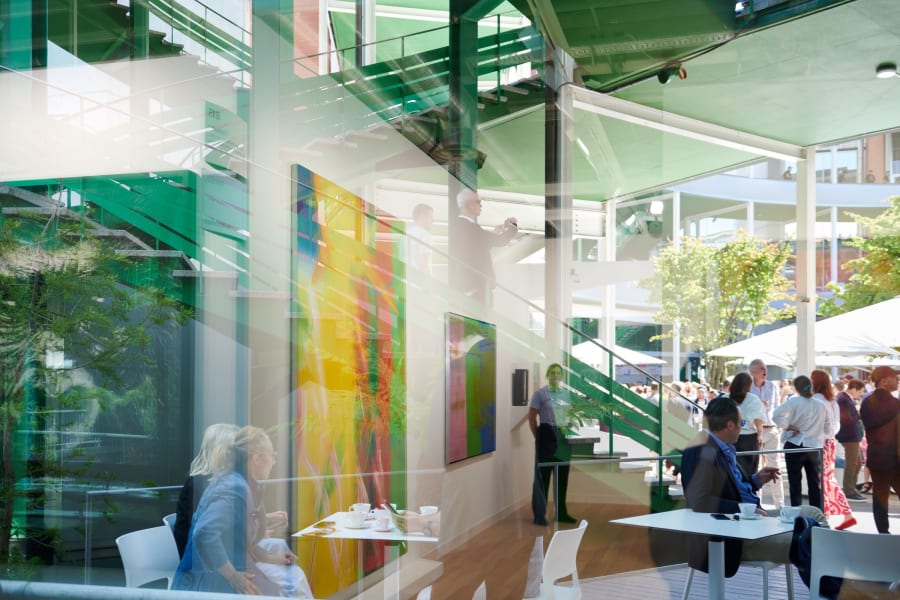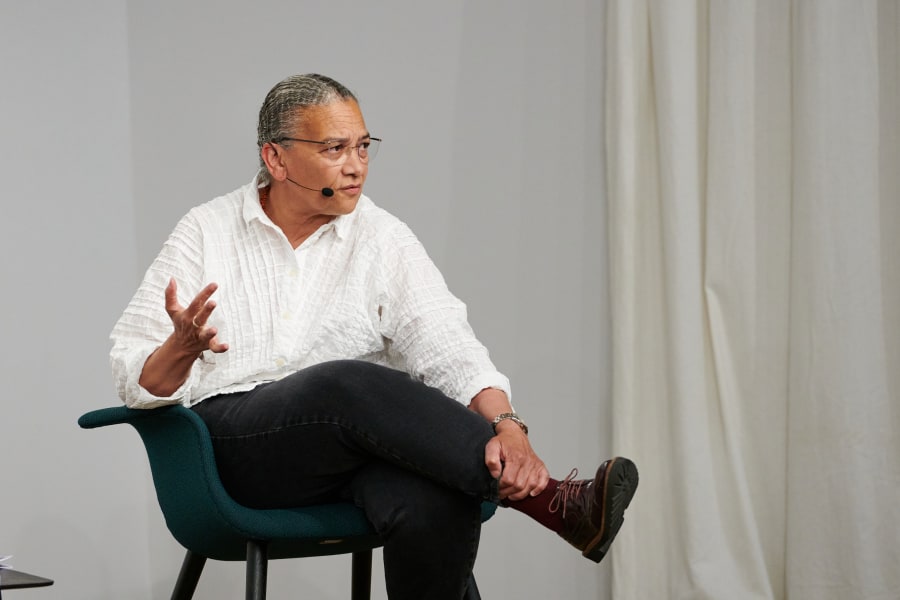Art fair booths might seem immaculately conceived, appearing within days – if not hours – adorned with spectacular works of art. But in reality, there is a small army of workers who make it possible: registrars handling logistics, construction crews building buildings within buildings, and technicians who are moving, installing, and de-installing the work – all within less than a week. It is far from an easy task, and it takes a certain type of person to do it.
Art Basel spoke to four leaders from the art handling and logistics industry, all of whom share a talent for handling some of the world’s most precious artworks, an ability to meet the needs of high-powered collectors, and a bone-deep understanding of what it takes to make fairs like Art Basel, which opens this week, come alive.
Leo Valencia started as an art handler in 2001, then founded his company LogicArt in 2009. ‘I’m not someone who comes from this world,’ Valencia says. His parents immigrated to the United States from Colombia in the 1960s, and they worked tough jobs. ‘I barely ever frequented art galleries or museums as a kid,’ he says, but now, he works with some of the most valuable artworks in the world, and has an abiding passion for both historical and contemporary works of art. ‘I’ve done things that I never thought were possible for me,’ Valencia says. ‘And it’s all because I have clients that trust me.’
LogicArt works with art collectors in Miami and New York, and when Valencia spoke to Art Basel, he and his team were doing the mad dash before Art Basel in Basel opens. ‘This is the scramble. People are solidifying contracts and agreements – things are moving very fast for us right now,’ he says. For this edition in Basel, his team has been shipping works by George Condo, Sol LeWitt, Yayoi Kusama, John Baldessari, and Urs Fischer. When asked about what visitors to a fair might not be aware of, he says, ‘A big thing that people don’t really realize is that a lot of the works hanging in the booths don’t belong to the galleries. A lot of times that work is consigned.’ This means that a collector, or a different gallery, has entrusted the exhibiting gallery to sell the work on their behalf.
Besides upholding industry standards in the handling and shipping of these works, Valencia mentions another key facet of the art logistics business. ‘We have the privilege of being in people’s private homes, in their private collections. There are all sorts of things that we see and hear – but we’re an invisible presence in these rooms,’ he says. 'A huge part of what we sell in our business is discretion.’
Crozier Fine Arts, with 54 technicians on the ground working with 70 galleries in Basel, is one of the larger logistics companies present at the fair. James Hendy, its senior vice president and general manager based in San Francisco, oversees Crozier’s global business, which includes over 40 facilities, 160 vehicles, and 700 employees. The art handlers and drivers, those on the ground doing the hard labor, ‘are the people that make our business successful,’ says Hendy. ‘They’re putting a Picasso on a truck, and they’re hanging it in a private person’s home whilst elevated 30 ft up in a lobby on a gantry.’
Crozier’s technicians are involved at every stage of the logistics process: picking up work from collectors and galleries, crating it, storing it at their facilities, handling customs and shipping, installing, de-installing, and then shipping it back, either to new owners or back to the galleries or artists. Besides all of this labor, Hendy says that the handlers are also barometers for the market. ‘The amount of changeovers we’re doing, the requests from galleries during the week – it really gives us a good pulse on where the art market is at.’
Hendy brings up an important question regarding art logistics: sustainability. As noted in The Art Basel and UBS Art Market Report 2024, debates continue to swirl about the environmental sustainability of a dense art market calendar when weighed against sales. ‘One of the things that we really push as a company is the increased use of sea freight,’ Hendy says. Shipping by sea has a much lower carbon footprint and is also more affordable – an attractive option for smaller and mid-sized galleries in particular – but it is a much slower process than shipping by air.
Andrew Horton, project manager for Fritz Ewins and based in New York, has spent years on the ground at art fairs. ‘You’re trying to turn this whole thing around in about 48 hours,’ Horton says. ‘You’re coming in and it’s a totally blank slate – and then you have to turn it into Art Basel.’ Horton sees the preparation that goes into art fairs more along the lines of event production rather than a museum installation. ‘The entire place is abuzz with people working all at one time. It gets pretty crazy in there.’
Before the art handlers and technicians can do their jobs, other crews have to build the infrastructure. With everything happening all at once, it is not always a simple, step-by-step process. ‘We might be trying to drop off art in a booth, but they’re still painting the walls, or, they haven’t wired up electricity,’ Horton says.
The art handling world is a tight-knit group; everyone knows everyone, and whether it is in Basel or Miami Beach or Hong Kong, building an art fair depends on the smooth operation of a wide variety of workers from different companies. ‘Once the installs are done, you would think everyone’s first priority would be going back to their hotels and go to sleep. But that’s when everyone actually gets to hang. At Art Basel, we all can get together and see people we haven’t seen in a while.’ In Switzerland, there even exists a sort of commune named ‘The Collective,’ whose members travel the world installing fairs, Art Basel included, and live together on a goat farm.
If you hang around the local pub where art handlers are relaxing after a day’s work, you would notice that most are men. Natalie Cothren is not only an exception to that, she has also seen the tides change. ‘Every year that goes by, you start seeing some new faces,’ she says. ‘There are many more women and people of color.’ A managing partner for Acumen Fine Art Logistics, Cothren has worked in the business for 15 years, and at Art Basel in Basel for seven of those.
When asked what it is like to install an art fair, Cothren drops an interesting comparison. ‘I’ve never done a biathlon,’ she says – referring to the event that combines high-speed cross-country skiing and shooting targets with a rifle – ‘but that’s kind of what it feels like.’ Art technicians need to not only be strong and work fast; they must also be extremely delicate and precise. ‘It’s not just a brute strength job, not that there aren’t women out there that aren’t brutally strong,’ Cothren says. ‘The technicians that go to fairs are a particular breed.’
Cothren still sometimes feels like she needs to prove herself to some of the men who are working – but it does not last for long. ‘There’s a new understanding of the fact that it is a job that really anyone can do,’ she says. ‘As long as you understand the experience needed to handle something properly.’
Art Basel in Basel runs June 13-16, 2024. Buy your tickets here and find out more here.
Rob Goyanes is a writer and editor from Miami, Florida. His work has appeared in BOMB, e-flux journal, Frieze, Los Angeles Times, and elsewhere. He lives in Los Angeles, California.
Caption for top image: a view of Art Basel Hong Kong 2024.
Published on June 11, 2024.


